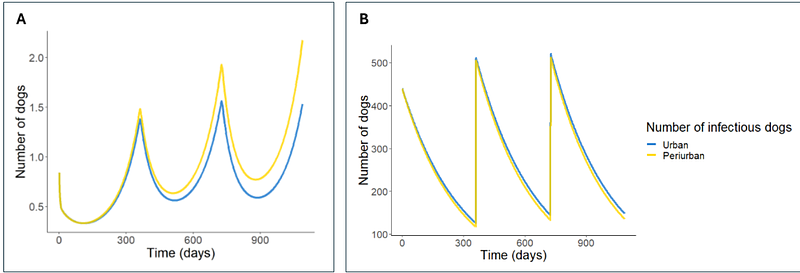Highly Dynamic Population of Owned Dogs and Implications for Zoonosis Control

Highly Dynamic Population of Owned Dogs and Implications for Zoonosis Control
Diaz, E. W.; Sila, S.; Raynor, B. B.; De la Puente-Leon, M.; Levy, M. Z.; Castillo-Neyra, R.
AbstractBackgroundDomestic dogs are known carriers of a variety of zoonotic pathogens significant to public health including leishmaniasis, echinococcosis, and, the most lethal, rabies. Control efforts for rabies and other diseases focus on the removal of infected individuals and mass treatment or vaccination to reduce incidence and raise immunity in the susceptible population. However, the complex population dynamics surrounding free-roaming dogs in many developing countries complicate these control methods. While rabies vaccination coverage of 70% or higher, of the dog population at risk, performed annually, should be sufficient to maintain coverage above the critical threshold, rapid population turnover and growth could reduce effective coverage. Our objective was to investigate the impact of dog population dynamics on rabies control activities in a rabies-endemic city.\n\nMethodologyUsing data from annual door-to-door surveys in urban and periurban areas, we collected household information (e.g., number of residents), respondent characteristics (e.g., education level), and dog-related data (e.g., vaccination status). These variables were analyzed to evaluate changes in the dog population and vaccination coverage. A compartmental Susceptible - Exposed - Infectious - Vaccinated (SEIV) mathematical model was utilized to estimate the effects of population dynamics on herd immunity against rabies.\n\nFindingsWe found that the highly dynamic dog population in Arequipa and its rapid expansion hampers herd immunity, counteracting the efforts made in yearly vaccination campaigns and leading to underestimates of the human to dog ratios ([~]4:1 vs 6:1). Moreover, there are significant differences in dog population trends within urban and periurban areas indicating that different strategies or coverage vaccination targets might be needed. This study also introduces an important variable of interest: transient dogs, a population with extremely high turnover (less than one year), which causes an important drop in vaccination coverage that has thus far gone undetected.\n\nConclusionsStabilizing the free-roaming domestic dog population by lowering both mortality and birth rates may help improve the efficacy of current mass vaccination programs. Additionally, the population dynamic parameters, on which we base our models, must be regularly refined to best represent the current status of disease risk and population immunity. By using a One Health approach we can understand and address the dynamics of dog populations, and better control zoonotic diseases like rabies, ultimately improving public health.